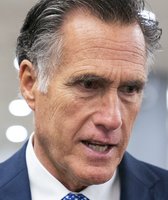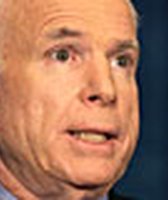Stand up for the facts!
Our only agenda is to publish the truth so you can be an informed participant in democracy.
We need your help.
I would like to contribute
SUMMARY: The Republican National Committee oversimplifies things a little to calculate the cost of Sen. Hillary Clinton's policy proposals, but mostly it isn't off the mark.
When a presidential candidate says, "I have a million ideas. The country can't afford them all," opponents are bound to jump on the comment.
So, when Clinton said that to the Boston Globe editorial board in October, she may as well have painted a big target on herself.
Taking aim? The Republican National Committee, which created the "Spend-O-Meter" to add up the cost of Clinton's policy proposals.
"If Sen. Hillary Clinton could enact all of her campaign proposals, taxpayers would be faced with financing more than $777.6-billion in new spending over one White House term," the RNC says on its Web site, www.gop.com, where the meter is prominently featured.
Sign up for PolitiFact texts
PolitiFact's Truth-O-Meter finds that the RNC's Spend-O-Meter does a pretty good job with the calculations. To be sure, the Spend-O-Meter makes some assumptions to simplify the arithmetic, and it overlooks arguments by the Clinton campaign that some of the spending would be covered by cuts and savings she anticipates making in other programs.
Some other caveats: The RNC includes $80-million for a savings bond program for babies that Clinton mentioned as an idea but then dropped. The Spend-O-Meter also fails to mention that some of her proposals already have been put into legislation that is supported by some Republicans in Congress.
Still, in 19 out of 24 examples cited by the RNC, the Spend-O-Meter is on target in describing Clinton's campaign proposals, putting them in the proper context and providing the amount she would spend.
Here's an example of how the RNC does its figuring. The RNC notes that Clinton has proposed an energy investment plan that involves spending $150-billion over 10 years, which would be equal to $15-billion a year. The RNC takes the $15-billion and multiplies by four, the number of years in a presidential term, to arrive at $60-billion. And so, the RNC adds $60-billion to the Spend-O-Meter. (The source for the $150-billion figure is Clinton's campaign Web site, www.hillaryclinton.com.)
The assumption the RNC makes is that Clinton's energy plan is passed by Congress, without amendment, at the very start of her first term. It also assumes that the spending will space out perfectly in year-to-year increments, which almost never happens with federal programs.
The same is true when it comes to Clinton's health care overhaul. She proposes spending $110-billion per year on the plan. The RNC simply multiplies that amount by four and comes up with $440-billion. That assumes the federal government would spend the same amount every year on the program, even though Clinton's proposal isn't all that clear about how the spending would work.
The real fault of the Spend-O-Meter is that it includes Clinton's idea to give each baby born in the United States a $5,000 bond, which could cost some $80-billion over four years. The proposal never went beyond the idea stage, and indeed Clinton's comment about having a million ideas was made in an attempt to explain why she had talked about it but never proposed it, according to the Boston Globe.
An RNC spokesman insisted that Clinton had discussed the baby bond plan on the campaign trail. "That is one that she particularly brought up," said Brian Walton of the RNC.
The RNC also fails to disclose that Clinton has Republican support for a couple of her proposals. The Spend-O-Meter tally includes a Clinton plan to provide $10-billion for education in developing countries over five years. That proposal is included in legislation that Clinton co-sponsored in the Senate with Sen. Gordon Smith, a Republican senator from Oregon.
In the House, a similar bill was introduced by Rep. Nita Lowey, D-N.Y., and Rep. Spencer Bachus, an Alabama Republican. The Republican National Committee does not disclose the GOP support of the Clinton plan.
Then there's the $250-million proposal to create a U.S. Public Service Academy. The RNC correctly states that Clinton introduced the bill with some Democrats and mentions Sen. Arlen Specter, R-Pa., and Rep. Christopher Shays, R-Conn., as co-sponsors. Shays and Specter are among the more liberal Republicans in Congress.
The RNC does not mention that Sens. Kay Bailey Hutchison, R-Texas, and Norm Coleman, R-Minn., two less liberal Republicans, also co-sponsored the legislation.
The Clinton campaign disputes the entire notion of the Spend-O-Meter. Campaign spokesman Mo Elleithee said in an e-mail that Clinton has specified how she would pay for every proposal, and cites Clinton's plan to cut 500,000 federal contractors over the next 10 years. Clinton has proposed that cut as a way to pay for her plan to provide universal prekindergarten to all students.
Most of Clinton's proposals do include specific details about how she would pay for the programs. For instance, she would partially pay for her plans to expand access to a college education and create a 401(k) for all Americans by making changes to the estate tax that would affect the wealthy.
And she would pay for her expansion of the National Science Foundation by ending tax breaks for companies that shift jobs overseas. She contends that savings found in her health plans would generate as much as it would spend. The RNC does not talk about any of the means by which Clinton would pay for her programs.
The Spend-O-Meter oversimplifies campaign pledges. It's catchy and has been picked up by blogs and others interested in the presidential campaigns. As a gimmick, it has its flaws. But even when those flaws are taken into account, the folks at the RNC are not being too heavy-handed as their fingers dance on their calculators.
Our Sources
Republican Spend-O-Meter, "Spend-O-Meter"<
Clinton campaign NIH Funding
Clinton campaign NSF Funding
Clinton campaign Health care
Clinton campaign, 401K Plan
Clinton campaign College tax credit
Clinton campaign Family leave
Clinton campaign NIH and Cancer Institute
Clinton campaign Energy proposal



































